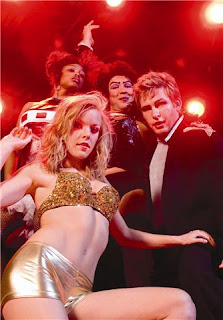Summer comes, things slow down.
As a reporter you gotta shift gears (but not like I did on my car recently – transmissions are way too expensive.)
And then, a bunch of stuff happens.

Discover a new artist
First we should all thank the Columbia Museum of Art for regularly opening shows during the summer and this one sounds good.
“Cleve Gray: Man and Nature” is composed of about 50 large abstract paintings by a guy you may not know much about but who did some tremendous paintings and was an interesting fella, too. Well-to-do, married to a great writer, lived most of his life in the house where he grew up, Jewish, a big opponent of the Vietnam war, worked like mad and played a mean tennis game.
It opens Friday, June 26.
You can read my full story about the show in the Free T
 imes on paper or at http://www.free-times.com
imes on paper or at http://www.free-times.comOh, and the City of Columbia should also thank the museum by increasing its slice of the hospitality tax pie rather than decreasing it or leaving it flat. Based on nothing more than all the people who came from all over to see the “Turner to Cezanne” exhibition, I’d say the museum has been the hospitality hit of the year. But I’m sure City Council has some pet project or pavilion they want to build with that money.
Rocky Horr
 or – the horror, the horror
or – the horror, the horrorI wouldn’t suggest it unless things have gotten much better since last week, but you’re going to or not going to see “The Rocky Horror Show” at Trustus regardless of what I say. Thursdays through Saturdays. If you sit on stage, Frank might sit on your lap.
I have asked Columbia artist Virginia Scotchie to visit the sculpture of
Richard O'Brien as the RHS character Riff Raff (left) in Hamilton, New Zealand. O'Brien, who also wrote the musical, grew up nearby. Scotchie is visiting Hamilton and other places on a tough teaching mission.
The young and not so young – in concert
The Sterling Chamber Players is doing its annual concert showcasing young musicians they’ve been working with.
“The Mentoring Project” Friday night at 8 features young players Caroline Cross and Alex Fricker, oboes, Ryan Knott, cello, Dalton Lugo, viola, and Jenna Wolfe, violin, joining the Sterling regulars.
The group will play Ludwig von Beethoven’s Piano Trio in E flat, the first movement from W.A. Mozart’s Piano Quartet in G Minor, A movement from Franz Schubert’s "Death and the Maiden.” And Suite for Two Oboes and English Horn by Jean-Baptiste Pergolese.
Tickets are $12 in advance and $15; $5 for students. (803) 252-200l.
Fire in the belly
Belly dancing, fire eating, fire dancing, belly eating.
Delirum Tribal and the Columbia Alternacirque do their things at the Art Bar Friday night. Shows are at 9:30 and 10:30. No cover, but bring cash for the hat.
Old Idea - new music

What to me sounds like the best thing isn’t until Tuesday, June 30, and takes us back to the art museum.
John Berman’s Old Idea is one of about a dozen jazz bands Berman juggles around Chicago. The group’s first recording was just released last month, so we’re getting them while they’re hot. Berman doesn’t go for the big blare of the coronet, which is what he plays, and there’s improvisation, not just noodling.
“Neither raucous nor randomly improvised, Berman's music is built on carefully conceived compositions, gently expressed gestures and a transparent ensemble sound,” the Chicago Tribute wrote of his work.
The group consists of Berman, Keefe Jackson on tenor sax,
Jason Adasiewicz playing vibraphone, bassist Anton Hatwich and
Marc Riordan on drums.
The music starts at 7. It’s $8 for museum members, $10 for others.
Book signings
Brian Ray of Columbia is signing copies of his book "Behind the Pale Door," winner of the South Carolina First Novel Award, at the Barnes and Noble on Forest Drive. 2 p.m. Saturday, June 27.
Columbia writer Janna McMahan will be signing copies of her new novel, "The Ocean Inside" at Java Nook Books in Blythewood from 2 to 4 Saturday, June 27.
If you're down at the coast (and don't we all wish we were), artist Brian Rutenberg, a South Carolina native, will be signing copies of the big book about his work. You'll find him at Litchfield Books Friday, June 26 at 2.
Planning ahead
The Columbia City Ballet is pitching its next season and like most arts groups, could probably use your money now. If you buy a season ticket by the end of June, you get a free ticket to one of the performances. Prices are $80 to $160.
And of course buying a season membership is a ton cheaper than buying individual tickets – that goes for all performing arts groups.
Like the S.C. Philharmonic, which is also in full swing of selling season tickets, $72 to $250. And you really need to check out the hilarious and scary photos on the Philharmonic’s web site.







































